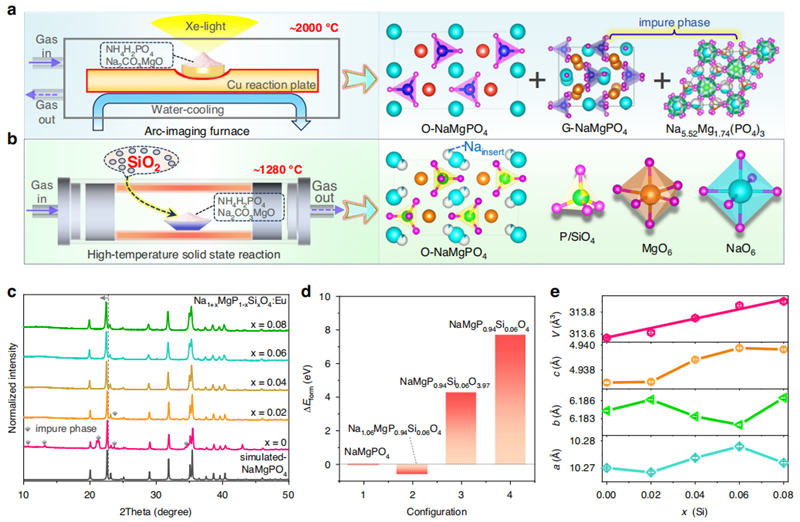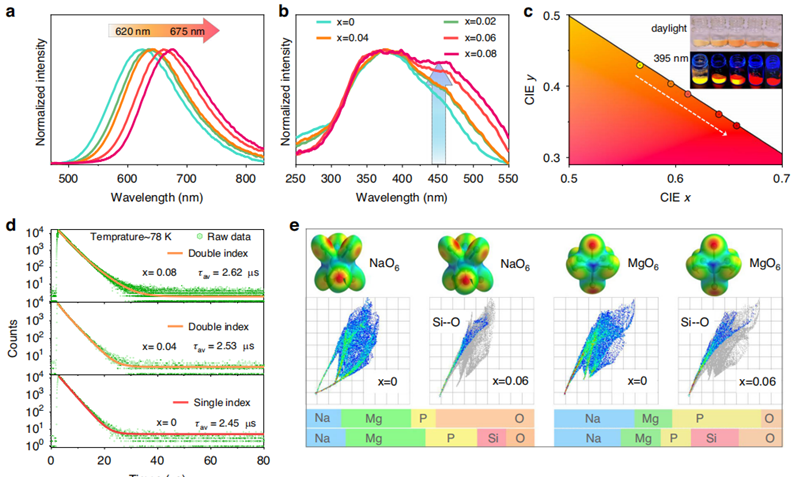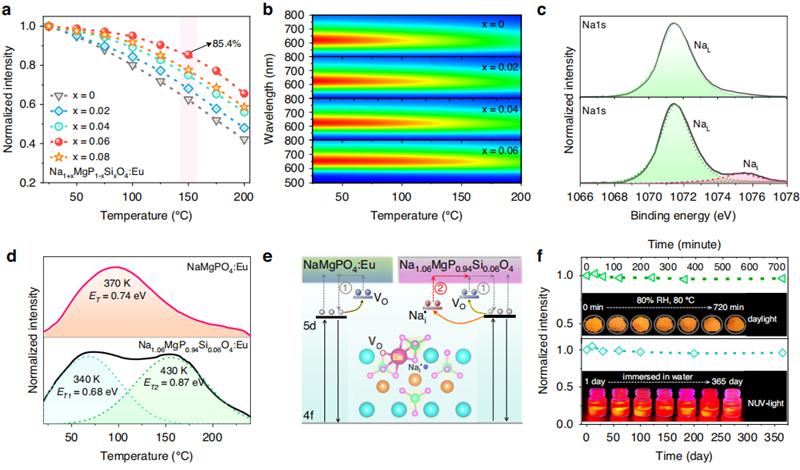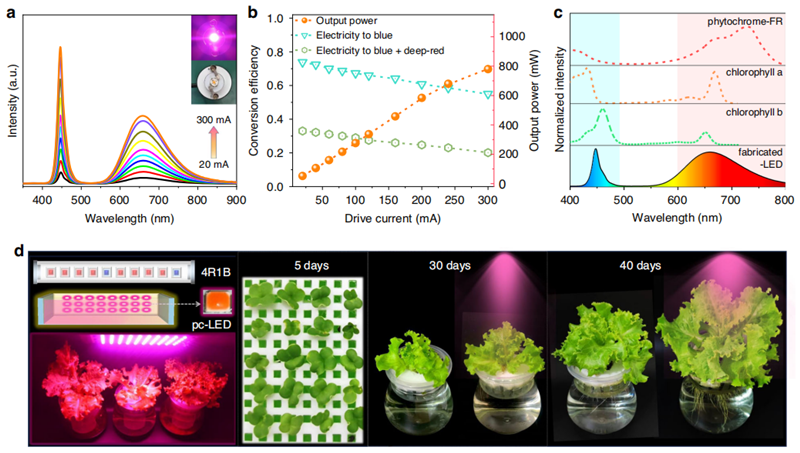来源:发光材料与器件
无机发光材料在光电设备应用方面前景广阔,但基于氧化物的深红色发光荧光粉效率有限且热稳定性差,阻碍了植物照明技术的发展。
在此,太原理工乔建伟\时秋峰\王磊LIGHT提出了一种简单的成分工程策略,以稳定相位、提高外部量子效率(EQE)并增强热稳定性。通过在 NaMgPO4:Eu 中引入 SiO4对 PO4 四面体进行化学改性,降低了形成能,从而生成纯橄榄石相,并将 EQE 从 27% 提升至 52%,创下氧化物深红色荧光粉的纪录。同时,引入的深缺陷能级使 150°C 时的热稳定性从 62.5% 提升至 85.4%。
此外,激发峰和发射峰分别移至 440 nm和 675 nm,与植物光敏色素的特定光谱吸收要求精确匹配。而且,在相对湿度 80% 和 80°C 条件下暴露 6 小时后,发光强度几乎无衰减,采用 Na1.06MgP0.94Si0.06O4:Eu 的 pc-LED 在 300 mA电流下实现了 780 mW的高输出功率。
他们的研究展示了一种优化无机发光材料性能的简便方法,并为低成本植物照明提供了替代方案。

Fig. 1: Synthesis method and structural characterization of olivine-type NaMgPO4:Eu2+phosphor.
a Schematic image of arc-imaging furnace and b traditional high-temperature solid state method, as well as the crystal structure of the synthesized products. c X-ray powder diffraction patterns of Na1+xMgP1-xSixO4:Eu2+ (x = 0–0.08) phosphors and the simulated pattern profile based on Rietveld refinement results. d Differences in formation energies for four different configurations calculated by using First-Principle calculations based on DFT. e Dependence of the lattice parameters (a, b, c, V) on the doping concentration of Si.

Fig. 2: Photoluminescent property of Na1+xMgP1-xSixO4:Eu2+ phosphors.
aEmission and b excitation spectra of Na1+xMgP1-xSixO4:Eu2+ (x = 0–0.08) phosphors. c CIE chromaticity coordinates of and the image of Na1+xMgP1-xSixO4:Eu2+ phosphors under daylight and 395 nm UV irradiation. d Decay curves and fitting results of Na1+xMgP1-xSixO4:Eu2+ (x = 0, 0.04, 0.08) measured at 78 K under 450 nm pulse laser diode excitation. e Hirshfeld surface and 2D finger print plots with di and de ranging from 0.6 to 2.4 Å calculated by Crystal Explorer software

Fig. 3: The quantum efficiency of Na1+xMgP1-xSixO4:Eu2+phosphors.
a The internal/external quantum efficiency and absorption coefficient of Na1+xMgP1-xSixO4:Eu2+ phosphors. b Comparison of external quantum efficiency of Na1.06MgP0.94Si0.06O4:Eu2+ with the oxide-based red and deep-red phosphors reported to date, including CsMgPO4:Eu (CMPO), Sr3YAl2O7.5:Eu (SYAO), LiSrBO3:Eu (LSBO), Rb3YSi2O7:Eu (RYSO), SrY2O4:Eu (SYO), Sr2Sc0.5Ga1.5O5:Eu (SSGO), Ca4(PO4)2O:Eu (CPO), Sr2ScAlO5:Eu (SSAO) and Ca1.2Eu0.8SiO4 (CESO). c Eu L3-edge X-ray absorption near-edge structure spectra of the reference sample (Eu2O3), NaMgPO4:Eu2+ and Na1.06MgP0.94Si0.06O4:Eu2+ samples

Fig. 4: Stability of synthesized phosphors to heat and water. a Normalized emission intensities and b temperature dependent emission spectra of Na1+xMgP1-xSixO4:Eu2+ (x = 0–0.08) as a function of temperature in the range of 20–200 °C. c Na1s XPS spectra of NaMgPO4:Eu2+ (up) and Na1.06MgP0.94Si0.06O4:Eu2+ (down). d Thermoluminescence spectra of NaMgPO4:Eu2+ and Na1.06MgP0.94Si0.06O4:Eu2+ in the temperature range of 25–200 °C. e Schematic illustration of the thermal quenching process mechanism in NaMgPO4:Eu2+ and Na1.06MgP0.94Si0.06O4:Eu2+. f Water-stability of Na1.06MgP0.94Si0.06O4:Eu2+ powder

Fig. 5: Performance and application of fabricated pc-LEDs.
a Electroluminescent (EL) spectra and photographs of the LED fabricated using a GaN chip (λmax = 440 nm) and Na1.06MgP0.94Si0.06O4:Eu2+ phosphor encapsulation under current of 20-300 mA. b Output power, electricity-to-blue light and electricity-to-purple light conversion efficiency under various drive current. c Comparation of the EL spectra of fabricated LED with absorption spectra of chlorophyll-a, chlorophyll-b and phytochrome-FR in plants. d Schematic diagram of commercial 4R1B plant growth lighting device and the fabricated pc-LED, as well as photos of lettuce cultivation under various lighting conditions